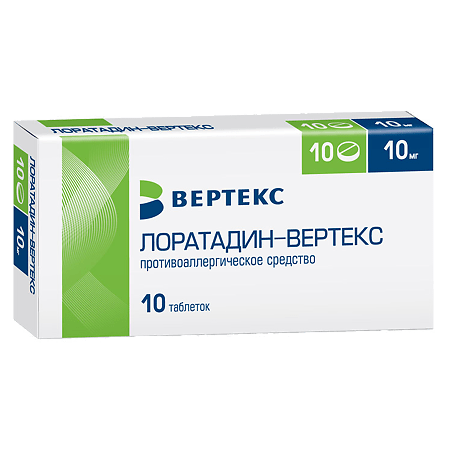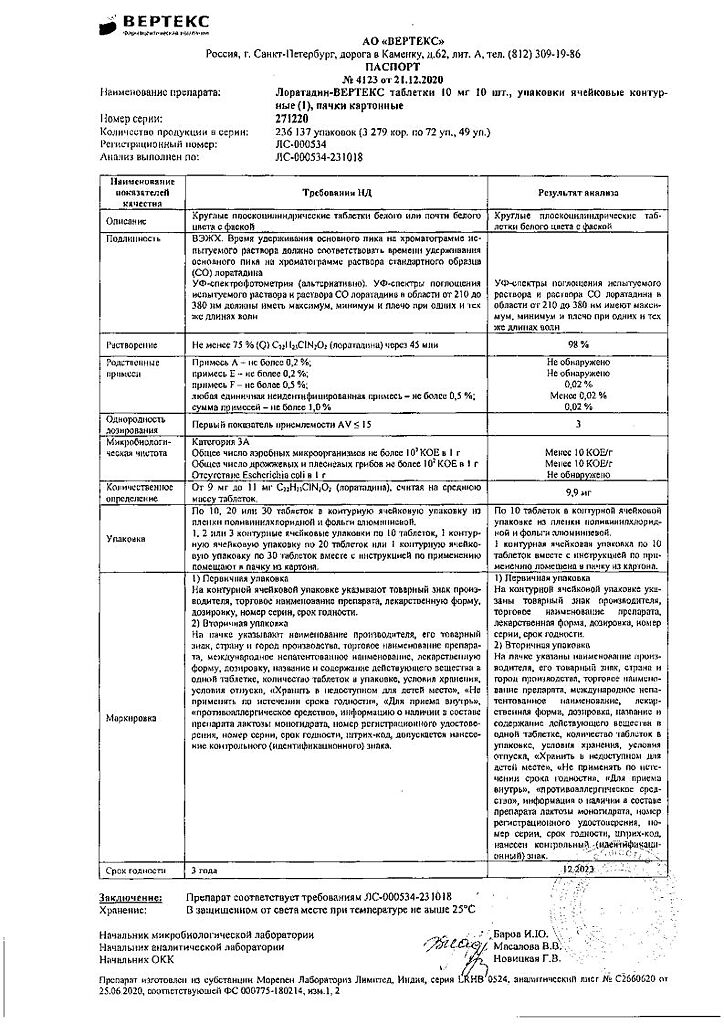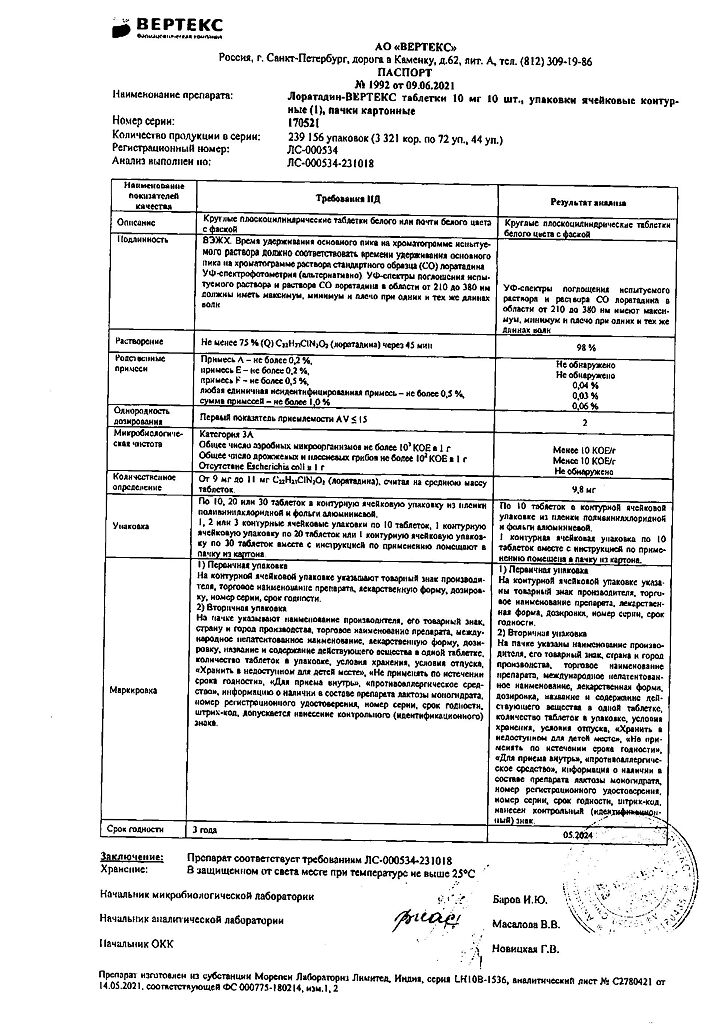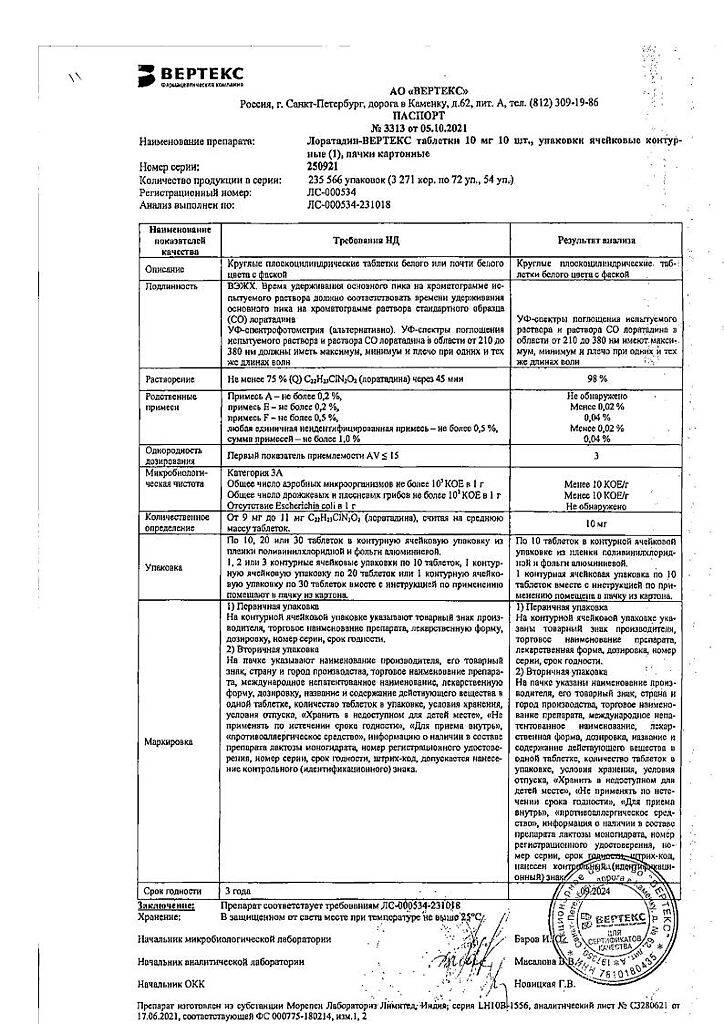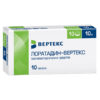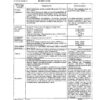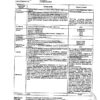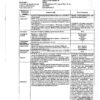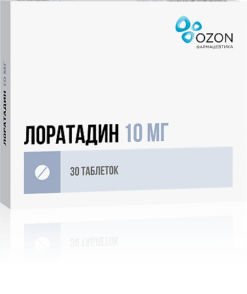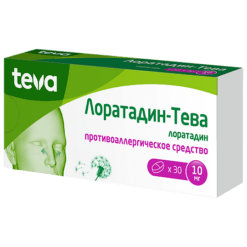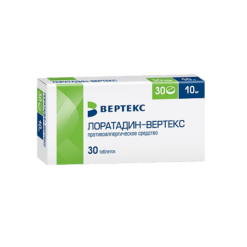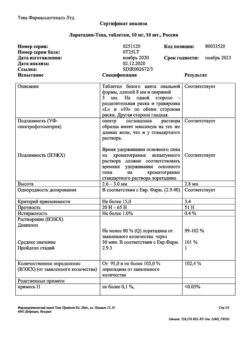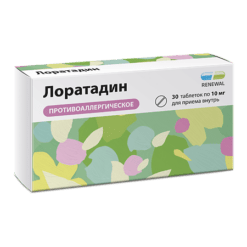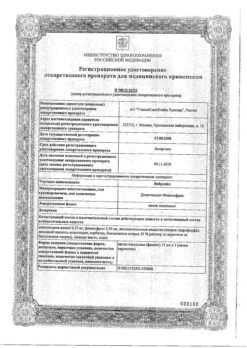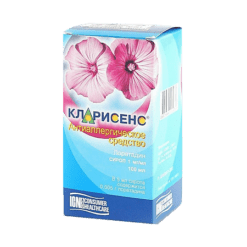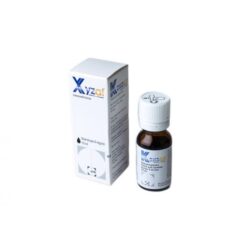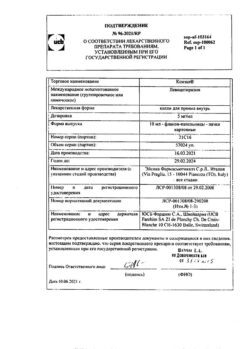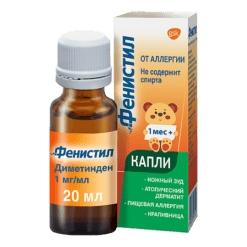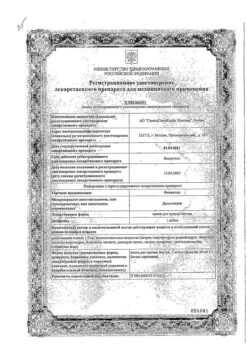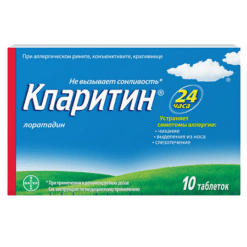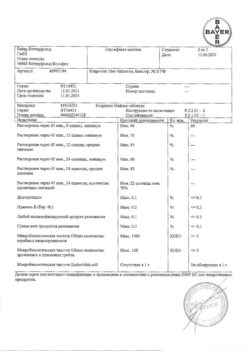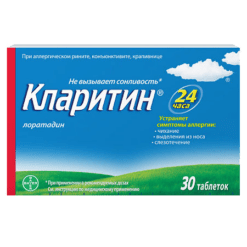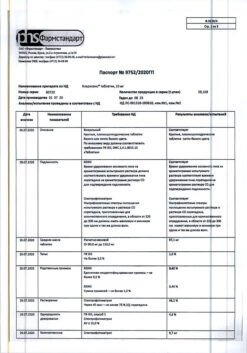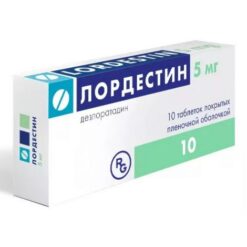No products in the cart.
Description
Pharmgroup:
An antiallergic agent – H1-histamine receptor blocker.
Pharmic action:
Loratadine is a blocker of H1 -histamine receptors (long-acting). Inhibits the release of histamine and leukotriene C4 from mast cells. It prevents the development and facilitates the course of allergic reactions.
It has antihistamine, anti-allergic, antipruritic and antiexudative action. It reduces capillary permeability, prevents the development of tissue edema, relieves smooth muscle spasm. Antiallergic effect develops after 30 minutes, reaches its maximum after 8-12 hours and lasts for 24 hours.
It does not affect the CNS and is not addictive (because it does not penetrate through the blood-brain barrier).
Pharmacokinetics:
It is quickly and completely absorbed in the gastrointestinal tract. Tmax is 1.3-2.5 h; ingestion slows it down by 1 h. Cmax in the elderly is increased by 50%, in alcoholic liver damage depending on the severity of the disease. The binding to plasma proteins is 97%. Metabolized in the liver with the formation of the active metabolite descarboethoxyloratadine with the participation of cytochrome P450 isoenzymes, CYP3A4 and, to a lesser extent, CYP2D6. Equilibrium concentration of loratadine and metabolite in plasma is reached on day 5 of administration. Does not penetrate through the HEB.
The T1/2 of loratadine is 3-20 h (mean 8.4 h), active metabolite is 8.8-92 h (mean 28 h); in elderly patients, respectively, 6.7-37 h (mean 18.2 h) and 11-38 h (17.5 h). In alcoholic liver damage the T1/2 increases depending on the severity of the disease. It is excreted by kidneys and with bile. Pharmacokinetics practically does not change in patients with CKD and in hemodialysis.
Indications
Indications
— Seasonal and year-round allergic rhinitis (including hay fever);
— allergic conjunctivitis;
– urticaria (including chronic idiopathic);
— Quincke’s edema;
– allergic itchy dermatoses;
– pseudo-allergic reactions;
– allergic reactions to insect bites;
– itching of various etiologies.
Pharmacological effect
Pharmacological effect
Pharmaceutical group:
antiallergic agent – H1-histamine receptor blocker.
Pharmaceutical action:
Loratadine is a H1-histamine receptor blocker (long-acting). Inhibits the release of histamine and leukotriene C4 from mast cells. Prevents the development and facilitates the course of allergic reactions.
It has antihistamine, antiallergic, antipruritic and antiexudative effects. Reduces capillary permeability, prevents the development of tissue edema, relieves spasm of smooth muscles. The antiallergic effect develops after 30 minutes, reaches a maximum after 8-12 hours and lasts 24 hours.
Does not affect the central nervous system and is not addictive (because it does not penetrate the blood-brain barrier).
Pharmacokinetics:
Quickly and completely absorbed into the gastrointestinal tract. Tmax – 1.3-2.5 hours; food intake slows it down by 1 hour. Cmax in elderly people increases by 50%, with alcoholic liver damage, depending on the severity of the disease. Communication with plasma proteins – 97%. Metabolized in the liver to form the active metabolite descarboethoxyloratadine with the participation of cytochrome P450 isoenzymes, CYP3A4 and, to a lesser extent, CYP2D6. The equilibrium concentration of loratadine and metabolite in plasma is achieved on the 5th day of administration. Does not penetrate the BBB.
T1/2 of loratadine – 3-20 hours (average 8.4 hours), active metabolite – 8.8-92 hours (average 28 hours); in elderly patients, respectively, 6.7-37 hours (average 18.2 hours) and 11-38 hours (17.5 hours). With alcoholic liver damage, T1/2 increases depending on the severity of the disease. Excreted by the kidneys and bile. In patients with chronic renal failure and during hemodialysis, the pharmacokinetics remain virtually unchanged.
Special instructions
Special instructions
Impact on the ability to drive vehicles and operate machinery
During the treatment period, it is necessary to refrain from engaging in potentially hazardous activities that require increased concentration and speed of psychomotor reactions.
Active ingredient
Active ingredient
Loratadine
Composition
Composition
1 tab.:
– loratadine 10 mg
Excipients:
lactose,
calcium stearate,
colloidal silicon dioxide (aerosil),
ludipress.
Pregnancy
Pregnancy
The safety of loratadine during pregnancy has not been established.
The drug should be used during pregnancy only when the expected therapeutic effect for the expectant mother outweighs the potential risk to the fetus. Loratadine and its active metabolite are excreted into breast milk; therefore, when prescribing the drug during breastfeeding, the issue of stopping breastfeeding should be considered.
Contraindications
Contraindications
– Hypersensitivity to loratadine or any other component of the drug;
– breastfeeding period;
– age up to 6 years;
– lactase deficiency, lactose intolerance, glucose-galactose malabsorption.
With caution:
Side Effects
Side Effects
The adverse events listed below occurred with an incidence of >2% with loratadine and approximately the same incidence as with placebo (“dummy”).
In adults: headache, fatigue, dry mouth, drowsiness, gastrointestinal disorders (nausea, gastritis), as well as allergic reactions in the form of a rash. In addition, there have been rare reports of anaphylaxis, alopecia, liver dysfunction, palpitations, and tachycardia.
Rarely in children: headache, nervousness, sedative effect.
Interaction
Interaction
Ethanol reduces the effectiveness of loratadine.
Erythromycin, cimetidine, ketoconazole, when used together with loratadine, increase the concentration of loratadine in the blood plasma without causing clinical manifestations or affecting the ECG.
Inducers of microsomal oxidation (phenytoin, barbiturates, zixorin, rifampicin, phenylbutazone, tricyclic antidepressants) reduce the effectiveness of loratadine.
Overdose
Overdose
Symptoms
Drowsiness, tachycardia, headache. In case of overdose, consult a doctor immediately.
Treatment
Symptomatic gastric lavage (preferably 09% sodium chloride solution) and intake of adsorbents (crushed activated carbon with water).
Loratadine is not eliminated by hemodialysis.
Storage conditions
Storage conditions
The drug should be stored at room temperature (15°C-25°C), in a dry place, out of reach of children.
Shelf life
Shelf life
2 years.
Manufacturer
Manufacturer
Vertex, Russia
Additional information
| Shelf life | 2 years. |
|---|---|
| Conditions of storage | The drug should be stored at room temperature (15°C-25°C), in a dry place out of reach of children. |
| Manufacturer | Vertex, Russia |
| Medication form | pills |
| Brand | Vertex |
Other forms…
Related products
Buy Loratadine-Vertex, tablets 10 mg 10 pcs with delivery to USA, UK, Europe and over 120 other countries.

